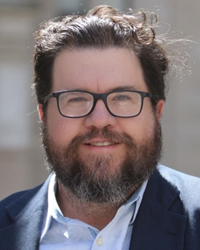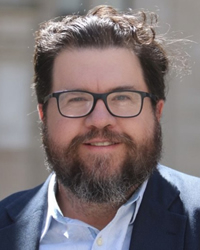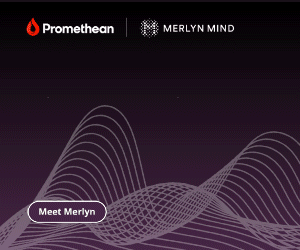The Culture Conscious Campuses Model which has been approved by the Texas Education Agency commissioner as a research-based instructional model with proven results in increasing academic success for African American students as well as students from low socio-economic backgrounds, regardless of their race or ethnicity. Host Kevin Hogan talks to the author.
The computer-generated transcript is below:
Kevin Hogan
OK. Hello and welcome to this month’s episode of Innovations and Education. Where we here in eSchool news explore the transformative stories and initiatives shaping the landscape of learning. I’m your host, Kevin Hogan, and today we have a terrific journey to share with you, one that involves turning underachieving title one schools into overachieving success story. Now imagine a principal who has not only flipped the narrative, but also transformed the culture and climate of their schools, fostering an environment where every student can thrive. It was my pleasure to speak with Doctor Cynthia Wise, the principal and Chief academic officer for the Charter branch of Waco ISD in Texas. Doctor Weiss’s approach goes beyond traditional methods. She created something called the Culture Conscious Campus model. It’s a groundbreaking instructional model approved by the Texas Education Agency Commission. This model has demonstrated proven results in increasing academic success. Not only for African American students, but for all students from low socioeconomic backgrounds, irrespective of their race or ethnicity. Doctor Weiss’s impact is proven in the data. She has successfully turned around three title one schools to earn an A rating. At the beginning of the last school year, a significant percentage of her third graders were below their reading levels. But by the end of the year, Doctor Wise and her team achieved remarkable 26% improvement in reading proficiency among those students. In this conversation, we delve into the facets of Doctor Weiss’s story, the reputation she’s earned, the remarkable increase in reading achievement, and the ground breaking model that she created. Have a listen. OK. Doctor Wise, thank you so much for joining me today. I really appreciate your time and looking forward to your insights.
Dr. Cynthia Wise
Thank you Kevin, for having me. This is indeed an honor and a pleasure.
Kevin Hogan
Well, you know, I think we can just dive right into it. You know, you have a lot of work doing a lot of work over the past several years. I think since 2019 when your model was first kind of unleashed. And I want to ask you. At that time, that was before COVID and I am assuming that a lot of things have happened since then, but let’s get started where the inspiration for your model and from when your work springs from.
Dr. Cynthia Wise
Well, the cultural conscious campuses model and the wise and structural framework, it evolved from my belief that is never the children’s fault. It is ours. If children aren’t learning, it’s because teachers aren’t teaching them the way they should be taught. In order to master the curriculum and we as adults, are not doing our part to put systems and structures in place so that students can thrive.
Kevin Hogan
And so you know, that’s something that is a problem. Problem that I know from my reporting it it is. Society wide, I mean, there seems to be a recognition of it, but then how do you tackle it and how do you go from that concept and the and the worries of those problems and turn it into something that is a day-to-day practice in the classroom? It seems like that’s something you’ve been able to do so. Share with us some of some of those.
Dr. Cynthia Wise
Yeah, Kevin, I’ve spent my entire career working at title One schools, children that are in poverty, and I’m known across the state of Texas for reaching the African American child. But this model is for any student that is. Struggling. I believe that we have a moral and legal obligation to bring out of our children what already exists within them. I don’t believe that a students zip code should determine the quality of education they receive. 65% of the children that are entering school today, they will end up working in jobs that don’t exist yet because the future of the economy is in stem and that’s where the jobs of tomorrow will be. For example, AI. So how do we prepare? Our students for that, oftentimes when I take over struggling schools and and that’s primarily what I do turn around schools. I’m oftentimes presented with the scenario of white flight and I said to people, it’s not just white flight, it’s really middle class flight. Those parents that can afford to get out of a toxic system, they do but. The students that I serve, their parents don’t have a choice, so we have to do our job and turning these schools around and there is a sense of urgency. 5% of the students that are in poverty, the research is clear. Only 5% of those students will get out of poverty if we don’t educate them. When you’re dealing with children in poverty and children at title one schools, they don’t have the luxury. Of generational wealth, the luxury of someone is going to lead them a business they’re going to inherit a business. I mean, we spend time helping family members bury their loved ones, right?
And so, first of all, it starts with you have to like the children that you teach. I believe it was dying a day that said, children don’t care how much you know until they know how much you care, so you have to like and love the children that you teach. There is a sense of urgency. So we start with empowering our leaders, that we refocus them on their vision and mission skills and knowledge that are necessary. To grow teachers leaders because principals cannot do this work alone, you have to have you a strong team of teacher leaders. And of course your administrative team around. You and so in other words, we build leadership capacity. That’s where we start. You have to put those systems and processes in place that would transform the school culture. So that’s what makes the CCC model the culture conscious. Campus is modeled so successfully. But you have to also align culture with a strong academic program, so that’s where we start with leadership, because leadership does matter. And Kevin, you know the the research is very clear. Year a strong school culture is an important foundation for student achievement and growth.
It helps you retain more teachers and you get better. Student achievement in both reading and math and within building a strong school culture. You have to have strong. Student teacher relationship. This will fuel student engagement. This also motivates students. And you also have to have a culture of high expectations, right? Students have to have a sense of belonging in their learning environment. This also, if there’s a culture of high expectations, this fuels student engagement. And most teachers, they do not set high expectations. For all students. And the system in itself don’t reward high expectation mindsets as much as they do content and the teaching methods. So building a culture conscious campus is at the core of our work. When there is no order, there is no learning. So and and that’s where we start with focusing the leaders on the vision and mission. But then you have to to address. The discipline and just about I would go out and say 100% of any struggling school in a toxic environment, everything is out of control. Discipline is out of control. There is no order. So you have to bring order. You have to have those high expectations. For everyone, everyone is held accountable, including myself as a leader. So you gotta refocus them on the purpose, the vision and the mission. Why are we here? Why are we doing what we’re doing? And how does that? Look, OK. And so there has to be decorum in the school.
When I first took on this assignment at this chronic struggling school where I am now a a year ago. Oh my goodness. Unbelievable people would not believe that in America. Those there are still schools like this. Fights profanity. Total disrespect. Now, if you were to visit my school within one. Hey. Yes, ma’am. No, ma’am. Yes, Sir. No, Sir. Excuse me. Manners. Students are engaged in learning, and so a culture conscious campus is a student first as a student and has a student center culture, right. We believe our students are exceptional. We bring out of them what already exists within them. But we have to create those structures to drive to deeper learning faster where there’s no order. There is no learning and certain certainly there is no deep learning our curriculum here in the state of Texas is very rigorous, right? So students have to be laser. Focus uh under the student center culture. You have clearly defined and articulated rules, processes, and procedures for culture and instruction. Teachers are not sages on stages, they are facilitators, and chief learners also under a culture conscious campus, we have a culture. As I stated before about the research, has necessary to have that culture of high expectations under the culture conscious campus model. We have a culture of high expectation, Kevin. We say what we mean and we do what we say. We set high expectations for the students and adults. As I stated before, we hold everyone accountable, the students, the teachers, the parents, the administrators and myself as the campus leader, a culture conscious campus as a strong instructional culture we teach. For purpose and we align everything we do with the standards. The standards. That’s your current. Give them right. We teach the curriculum, not a test. So we align everything what we do with the standards. We strive not only for mastery, but for excellence. We also create those reflective spaces where teachers can grow. I train my leaders. Our leaders model reflective practices and they encourage constructive communication and collaboration across all staff, so we dedicate that meaningful time for that professional learning and you others may know it as professional development. Also, under a culture conscious campus, we have a culture of engagement we want to hear from our constituents, our consumers, IE our parents, our students, our community, our teacher because we know that we are stronger together. We value their input and we take what they say and improve upon our practices, so align with.
Having this strong building, a culture conscious campus and we have a strong comprehensive academic program and under that strong academic comprehensive program. There are 5 cornerstone characteristics, and they are non-negotiable. We will not budget on these and one would be first safe and inclusive schools. Now we know that students must feel safe in order to. Learn and that is why you have middle class flight, right? Number one. Parents want their children to feel safe. So we set and enforce our rules and procedures to keep all students safe. You know, I’m reminded and this is a team effort here I I was perusing. Facebook the other day and then I. Saw saw on Facebook where 50 Cent said that I don’t have a degree from Harvard, but I surround myself with people that do so you have to build a strong, cohesive team as the leader, and you lead out front. I tell people I am the chief learner. On my campus, I am not just a principal, I am an instructional leader. I lead by example. I perform my own PD, but yes, I do bring in other people who may have more expertise in a certain area than. I do so one cornerstone characteristic under the comprehensive academic program is safe and inclusive school. We meet the needs of all children, but first and foremost, they must feel safe when students are not safe in an environment, they don’t take risks. There’s a lot of bullying. Going on, we don’t tolerate bullying every morning during my announcements, I announced that we will not with the capital, NOT tolerate bullying. And if you’re someone is having an issue, you report it to your teacher. Any adult in the building let us handle it. So you do not. The second cornerstone characteristic under our comprehensive academic program is that we prepare our students for college and career readiness and also to be critical thinkers and problem solvers.
How do we do that, Kevin? We offer rigorous instructions. Across multiple innovative models, I was one CEO at a over an organization that had oversight over six of a district in school charter schools. So I had oversight over six of those campuses. And we encourage our campuses to we collaborate across campuses because that was very important that you come together as a team and you bounce off ideals and improve upon your practices. So preparing our children to be college and career ready and to be critical thinking and. Problem solver. We also tap into those soft skills and we do that through. Them into individual interventions and those real world experiences, such as in we include project based learning, vocational apprenticeships and that was more or less at I at the middle school field trips and more the third. Characteristic of the comprehensive academic program is developing the whole child. We develop students social, emotional, creative and cognitive capacities so students learn how to fail, learn, grow and progress. Our 4th comprehensive cornerstone characteristic of our comprehensive academic program is building those strong student and teacher relationships. We are friendly, but we are not their friends. Instead, the teachers are facilitators of learning for other children. They have to create structures, build those relationships that encourage our students to to be risk takers and enable success. And I I say I I I love this because it’s so true and you see more of this at the middle school and high school. You want to be their friend. You are not their friend. We are friendly. And the last cornerstone characteristic of our comprehensive academic component of our program is again community engage. Each man, as I stated before, we want to hear the input from our constituents and and and if I may conclude that this segment in terms of talking about the comprehensive academic component of the CC model and those are non negotiable. We grow teacher leaders, so in addition to culture being at the core of our work, we ensure that our leaders, they utilize and and our teachers research base, best practices, models and instructional. And work because we strongly believe when the teacher is ready, the student will appear. And so I just kind of gave you a little snippet. Yeah, a general overview of the comprehensive academic program of the CCC model.
Kevin Hogan
One thing that really fascinates me about your your descriptions of it, so many elements of it. Really, seeing that they were prescient before the pandemic. So the idea of student safety and when you talk about safety, that’s the mental well-being as well as physical well-being, right, the importance of communicating with the whole community, especially with parents that became something that was.
Speaker
I see.
Kevin Hogan
Hugely important during COVID terms of, you know, bringing them into. The they became teacher assistants at home right during the the remote time and then hopefully have kind of continued to be there together as well as teacher agency and the idea of teacher leaders coming in those first few months of the pandemic, everyone was kind of left to their own devices, right? I mean, the teachers were left to. Being in control of those classrooms, everyone kind of forgot about standards for a while there and just try to kind of keep everybody together. Have you seen a recognition of your work changed because of the, the, the past few years and and these sort of elements?
Dr. Cynthia Wise
You know, Kevin actually not do we show our students show progress and remember the Commissioner sharing that the Commissioner of Education in Texas, our the schools that I had oversight over our students, showed progress during the pandemic because you know what? We kept standards high. We didn’t use that. As an excuse to water down our curriculum, we held them accountable by Google meets in our Google Classroom. Our students had to come to class in your uniform. And we set our expectations. We made sure our parents know no one can be present in the room. They have to be totally engaged and they’re on from this time to that time. But we were already, you know, integrating technology into the classroom prior to COVID because our. Students were very familiar with Google Classroom and we actually showed growth during COVID when the. Schools were were. Let down and so we never lowered our standards. We kept high expectation throughout COVID as a matter of fact, one of my school was a blue ribbon nominated school. And all of that coming through COVID keeping those standards high. And of course, we had a comprehensive program that we put together plan that we put together to A to make those necessary changes during COVID.
Kevin Hogan
So when you look at the model and obviously when you are the the creator of it and you are the inspiration for it and working with it, the particular places you are. If one of our audience members is looking to implement something like this in their own school or their own district, but they don’t have a doctor wise there to kind of put the pieces together and and put it together, what is your advice for them in terms of trying to use these sort of strategies in their own districts?
Dr. Cynthia Wise
Well, as I stated before, it starts with structure. With with discipline, if your school is still struggling, I and I hear this all the time where the students are unruly, they’re not disciplined. You have to refocus, you have to stop what you’re doing. School. What’s going? But you have to bring. Assemble a strong team together and you have to address. The issues you have to get to the root of the problem and it is never the children. It is never the child. Children. If our children are not doing what they’re supposed to do, if they’re misbehaving, if they’re not focused on their academics, it’s because we are allowing them to do that. We are the adults in charge, and I often time tell them you put on your I am in charge. T-shirt. And you go to work, but you cannot fear the children that you teach. When I took over this assignment and all the other assignments and my turn around school, what I got from that? That teachers and others were afraid of children have for having stay safe. They are children, they they are going to do what we ask them to do. It is a non negotiable. So you assemble leaders that are out there. Principal teacher leaders. I believe in teacher leaders. You empower your teachers leader. You empower them by equipping them and you have procedures and processes in place and you enforce them with fidelity and in the words of Harry Wong, none of this will work without consistency. You have to be consistent. We say what we mean and we do what we say is not something this day and something different than next day. You have to be consistent or none of this will. Work now. Our secret sauce. I’m sorry. Special sauce is how we practice as educators. See we value diversity, equity and inclusion in our schools and all of that is built into the culture conscious campus campuses where students come first. You have to. Have the mindset of students come first. Student centered. It is not about Doctor. Guys I tell the teacher it’s not about you. It is about these students. We have been charged to make sure that these students get the best education possible if that if. They fail at. That it’s because of what adults did, Paul Pastor it at the time when I was the CEO. And first started my down that journey of being a CEO and having oversight over six of these schools, Doctor Paul Pasterick, who is now the CEO and President of the University of Arizona Global. And he was over all of the school system in New Orleans. And he helped turn that down, I guess I pronounced it right. But if you’re from New Orleans, problems and normal. But anyway, Doctor Pastrick told me at the time he was working with me. He said that children can’t wait while adults work through their issues. They can’t wait. So adults got to get it together and you come up with a plan and you implement that plan with fidelity. How does it look from the time you open the door to the time you send them home and everything in between? What does it looks like? And that’s what I found with a principal struggle with. What does it? Look like nobody if you never under study. Under a A a principle that was an exemplary principle, an outstanding leader. Then you don’t know what it looks like, right? And so often principles. And they’re so happy they got their principal. Now you know, we all thrive to be a principal. Those who want to. Because you want to make a difference in their lives of many children. But you don’t know what it looks like. Right. So you have to get your great mentor. Oftentimes they provide mentors for teachers, but they don’t for principals. And they don’t. And get your great mentor. Do your research, make sure materials and resources that you are using, that they are research based and and get on the phone and call that person. Call me if you like. I’d be glad to help but you have to refocus on your vision and your mission. And get order in that school first. And hold everyone accountable. Everyone, parents, students, teachers and ourselves.
Kevin Hogan
It’s good advice now when you look at the success that you have that you’ve had and and and continue to have. Let me ask you to look forward a little bit and see what your hopes are going forward. What are you seeing with your with your program? How do you see it, the models evolving? How do you what do you see as a definition of success? Say over the next two or three years.
Dr. Cynthia Wise
We using the reading Horizon reading program for an example. One of the best reading programs in my opinion that I have ever used. We took this school where when I first took over last year, 90% of these students were functional ill. Right. They were non readers within one year we that number was reduced to only 60% and we’re continuing to close that reading gap, right. So you have to make sure you have research based programs in place. And you can’t chase every little thing out there. Get something that. Works and stick with it, right? But I hope at the end of the the day that this model would be a blueprint for excellence and innovation and REACH more children in poverty so they can come back to their communities and be good people. Great citizens and help out in their communities.
Kevin Hogan
Well, it’s great stuff. And as I mentioned, I really appreciate your time and your. And so your your work is incredibly important and it’s great to hear that it’s having such a positive effect where you are and hopefully your ideas can spread to the folks who are reading and listening us today, so. Thanks again, doctor, I really appreciate it.
Dr. Cynthia Wise
Thank you so much. And and I didn’t say but happy New Year.
Kevin Hogan
To you happy. New year. Well, so that’s all for this month’s episode of Innovations and Education. Stay tuned for more episodes where we uncover the latest trends and innovations shaping the future of education. Once again I’m Kevin Hogan, and thanks for listening.
- SEO Powered Content & PR Distribution. Get Amplified Today.
- PlatoData.Network Vertical Generative Ai. Empower Yourself. Access Here.
- PlatoAiStream. Web3 Intelligence. Knowledge Amplified. Access Here.
- PlatoESG. Carbon, CleanTech, Energy, Environment, Solar, Waste Management. Access Here.
- PlatoHealth. Biotech and Clinical Trials Intelligence. Access Here.
- Source: https://www.eschoolnews.com/featured-podcast/2024/01/30/how-to-create-a-culture-conscious-campus/
- :has
- :is
- :not
- :where
- $UP
- 12
- 13
- 2019
- 25
- 250
- 31
- 4th
- 5
- 50
- a
- Able
- About
- academic
- academics
- acclaimed
- accountable
- achieved
- achievement
- across
- actually
- addition
- address
- administrative
- administrators
- Adult
- adults
- advice
- afraid
- African
- again
- agency
- ago
- AI
- align
- All
- Allowing
- alone
- already
- also
- am
- america
- American
- among
- an
- and
- announced
- Announcements
- any
- appear
- appreciate
- approach
- approved
- ARE
- AREA
- arizona
- around
- articulated
- AS
- ask
- assignment
- assignments
- assistants
- At
- audience
- audiences
- author
- back
- backgrounds
- base
- based
- BE
- became
- because
- been
- before
- Beginning
- being
- belief
- believe
- belonging
- below
- BEST
- best practices
- Better
- between
- Beyond
- Bit
- Blue
- blueprint
- both
- Bounce
- Branch
- brands
- Breaking
- bring
- Bringing
- budget
- build
- Building
- built
- bullying
- business
- but
- by
- call
- called
- Campus
- CAN
- cannot
- capacities
- Capacity
- capital
- care
- Career
- ccc
- cent
- Center
- centered
- ceo
- certain
- certainly
- changed
- Changes
- characteristic
- characteristics
- charge
- charged
- chase
- chief
- child
- Children
- choice
- Citizens
- class
- classroom
- clear
- clearly
- Climate
- Close
- code
- cognitive
- cohesive
- collaborate
- collaboration
- College
- COM
- come
- coming
- commentator
- commission
- commissioner
- communicating
- Communication
- Communities
- community
- component
- comprehensive
- computer-generated
- concept
- conclude
- conscious
- consistency
- consistent
- constructive
- Consumers
- content
- continue
- continued
- continuing
- control
- Conversation
- Core
- cornerstone
- course
- covering
- Covid
- create
- created
- Creative
- creator
- critical
- cultural
- Culture
- Current
- Curriculum
- data
- day
- day-to-day
- dealing
- dedicate
- deep
- deep learning
- deeper
- defined
- definition
- Degree
- delve
- demonstrated
- description
- Determine
- develop
- developing
- Development
- Devices
- DID
- difference
- different
- discipline
- disciplined
- district
- dive
- Diversity
- do
- Doctor
- does
- doing
- Dont
- Door
- down
- drive
- during
- Dying
- each
- earn
- earned
- economy
- editor
- educate
- Education
- educators
- effect
- effort
- elements
- empower
- empowering
- enable
- encourage
- end
- enforce
- engage
- engaged
- engagement
- ensure
- entering
- Entire
- Environment
- episode
- Episodes
- equity
- especially
- ethnicity
- EVER
- Every
- everybody
- everyone
- everything
- evolved
- evolving
- example
- Excellence
- exceptional
- executive
- exist
- exists
- expectation
- expectations
- experience
- Experiences
- expertise
- explore
- Face
- facets
- fact
- FAIL
- familiar
- family
- family members
- faster
- fault
- fear
- feel
- few
- fidelity
- field
- fights
- First
- flight
- Focus
- focused
- focusing
- For
- foremost
- Forward
- forward-thinking
- fostering
- found
- Foundation
- Framework
- friend
- friendly
- friends
- from
- front
- Fuel
- fuels
- functional
- future
- gap
- gave
- General
- generational
- generational wealth
- get
- Give
- Global
- Go
- Goes
- going
- good
- got
- great
- Ground
- groundbreaking
- Grow
- Growth
- guess
- had
- handle
- happened
- happy
- harvard
- Have
- having
- he
- hear
- Held
- hello
- help
- helped
- helping
- helps
- her
- here
- High
- hold
- Home
- honor
- hope
- Hopefully
- hopes
- horizon
- host
- How
- How To
- http
- HTTPS
- i
- idea
- ideals
- ideas
- ie
- if
- imagine
- Impact
- implement
- importance
- important
- improve
- improvement
- in
- In other
- include
- Including
- inclusion
- Inclusive
- Increase
- increasing
- incredibly
- indeed
- individual
- initiatives
- Innovation
- innovations
- innovative
- input
- insights
- Inspiration
- instead
- instructional
- instructions
- Integrating
- intersection
- interventions
- into
- involves
- irrespective
- issue
- issues
- IT
- itself
- Job
- Jobs
- joining
- journey
- jpg
- just
- Keep
- keeping
- kept
- Kind
- Know
- knowledge
- known
- landscape
- laser
- Last
- Last Year
- latest
- lead
- leader
- leaders
- Leadership
- LEARN
- learner
- learners
- learning
- left
- Legal
- less
- let
- levels
- like
- Listening
- little
- Lives
- Look
- look like
- looking
- LOOKS
- Lot
- love
- loved
- Low
- lowered
- Luxury
- made
- make
- MAKES
- man
- many
- master
- mastery
- materials
- math
- Matter
- May..
- me
- mean
- meaningful
- Media
- Meet
- Meets
- Members
- mental
- mentioned
- mentor
- mentors
- methods
- Middle
- Mindset
- Mission
- model
- models
- months
- moral
- more
- morning
- most
- much
- multiple
- must
- my
- myself
- NARRATIVE
- necessary
- needs
- never
- New
- New Orleans
- new year
- news
- next
- no
- nobody
- None
- normal
- note
- now
- number
- obligation
- of
- off
- offer
- Officer
- often
- oftentimes
- oh
- on
- once
- ONE
- ones
- online
- only
- open
- Opinion
- or
- order
- organization
- orleans
- Other
- Others
- our
- ourselves
- out
- outstanding
- over
- Oversight
- overview
- own
- pandemic
- parents
- part
- particular
- past
- Paul
- People
- percentage
- perform
- person
- phone
- photo
- physical
- pieces
- Place
- Places
- plan
- plato
- Plato Data Intelligence
- PlatoData
- pleasure
- positive
- possible
- Posts
- Poverty
- practice
- practices
- Prepare
- preparing
- present
- presented
- president
- primarily
- Principal
- principals
- principle
- principles
- Prior
- Problem
- problems
- procedures
- processes
- PROFANITY
- professional
- Program
- Programs
- Progress
- project
- pronounced
- proven
- provide
- purpose
- put
- quality
- Race
- rating
- reach
- reaching
- readers
- Readiness
- Reading
- ready
- real
- real world
- really
- receive
- recognition
- Reduced
- reflective
- Regardless
- relationship
- Relationships
- remarkable
- remember
- remote
- report
- Reporting
- reputation
- research
- Resources
- Results
- retain
- Reward
- Ribbon
- right
- rigorous
- Risk
- risks
- Room
- root
- rules
- safe
- Safety
- Said
- saw
- say
- scenario
- School
- Schools
- Second
- Secret
- see
- seeing
- seems
- seen
- segment
- send
- sense
- Sense of Urgency
- serve
- set
- several
- shaping
- Share
- sharing
- she
- should
- show
- showed
- significant
- since
- Sir
- SIX
- skills
- Snippet
- So
- Social
- Society
- socioeconomic
- Soft
- some
- Someone
- something
- spaces
- speak
- special
- spend
- spent
- spread
- Staff
- stages
- standards
- start
- started
- starts
- State
- stated
- stay
- Stem
- Stick
- Still
- Stop
- Stories
- Story
- strategies
- strive
- strong
- stronger
- strongly
- structural
- structure
- structures
- Struggle
- Struggling
- Student
- Students
- Study
- stuff
- success
- success story
- Successfully
- such
- supposed
- sure
- system
- Systems
- tackle
- Take
- takers
- Talk
- talking
- Talks
- Tap
- taught
- teacher
- teachers
- Teaching
- team
- Technology
- tell
- terms
- test
- texas
- than
- thank
- thanks
- that
- The
- The Capital
- The Future
- The Landscape
- The State
- their
- Them
- then
- There.
- These
- they
- thing
- things
- think
- thinkers
- Thinking
- Third
- this
- those
- three
- Thrive
- Through
- throughout
- time
- Title
- to
- today
- together
- told
- tomorrow
- took
- Total
- TOTALLY
- toxic
- traditional
- Train
- Transcript
- Transform
- transformative
- transformed
- Trends
- true
- try
- trying
- tuned
- TURN
- Turned
- Turning
- two
- uncover
- under
- university
- unleashed
- until
- upon
- urgency
- URL
- us
- use
- used
- using
- utilize
- value
- very
- vision
- Visit
- wait
- want
- was
- Water
- Way..
- we
- Wealth
- welcome
- WELL
- were
- What
- What is
- when
- which
- while
- white
- WHO
- whole
- why
- wide
- will
- WISE
- with
- within
- without
- wong
- words
- Work
- working
- works
- world
- would
- writer
- year
- years
- yes
- yet
- you
- Your
- zephyrnet
- Zip













